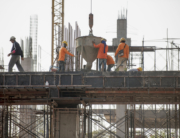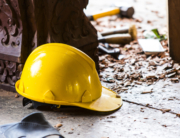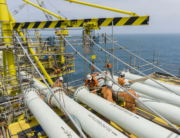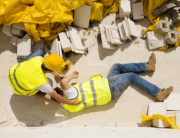Per the Occupational Safety and Health Administration (OSHA), one out of five worker deaths in America happens in the construction industry. That number would be even higher if the Department of Labor included highway collisions involving construction vehicles in this category.
The OSHA has studied why accidents occur on construction sites and found that four types of accidents are responsible for about 60% of all construction deaths. The “Fatal Four” are:
- Falls: Cause around 40% of construction fatalities
- Getting struck by an object: Result in a little over 8% of the industry deaths
- Electrocutions: Account for more than 7% of the fatalities
- Caught-in and between: Lead to about 5% of the deaths (This category includes when equipment or objects compress workers, the employees get caught in an object or machine, or there is a collapse of a structure, material, or equipment, and the worker gets crushed, caught, or struck.)
The Fatal Four kill between 500 and 600 construction workers a year.
OSHA says why accidents occur on construction sites is because constructions companies frequently violate federal safety standards concerning:
- Fall protection
- Scaffolding requirements
- Control of dangerous electricity and other power
- Ladders
- Training on the use of fall protection equipment
- Safety guards on machinery and equipment
- Protection for eyes and faces
The good news is that worksites, in general, are far less hazardous than they were about 50 years ago. In 1970, about 38 workers died per day. The death rate fell to 14 a day by 2017.
Nonetheless, 14 lives lost every day, seven days a week, is too high. At that rate, more than 5,000 people lose their lives on the job and close to 1,000 of those deaths happen in the construction industry. The Fatal Four account for nearly 600 of those fatalities.
How Accidents Happen on Construction Sites
According to OSHA, most, if not all, the causes of accidents occurring on construction sites that lead to injuries and fatalities are preventable. Construction companies need to follow federal safety regulations to protect workers.
Falls
OSHA urges contractors to follow these guidelines to avoid falls:
- Plan: Make a safety plan for each job. Make sure that all the needed safety equipment is at the job site. Include the cost of safety protocols when bidding jobs.
- Provide: Use the appropriate kinds of ladders and scaffolding for the job. When workers try to use items in an unintended manner, accidents can happen.
- Train: Do not let a worker start a job until he has completed the relevant training for the safety equipment. Do not assume that someone will figure it out as he goes. The incorrect use of safety equipment can be more dangerous than no safety equipment. A worker with a false sense of security on equipment that he is using improperly is going to fail.
Construction companies should not use a one-size-fits-all approach to preventing falls. Someone should go to the worksite and assess the unique needs of the job.
Ladders and Scaffolding
Workers can fall off of portable ladders and scaffolding, but these objects present additional risks as well. The wrong type of ladder or scaffold for the job can cause the equipment to collapse. Defective or worn ladders or scaffolding can also lead to a failure of the equipment. Sometimes scaffolding gets assembled incorrectly, which can cause it to fail.
Electrocutions
The general public does not realize how dangerous electricity and batteries can be. We use power 24 hours a day, and the vast majority of people never get hurt as a result.
Construction projects use massive amounts of electricity and battery power to run their tools and equipment. For the safety of the workers, construction sites need to control electrical hazards. When people get careless, workers can get electrocuted.
Here are some examples of preventable causes of electrocutions in construction:
- An electrical short in poorly maintained or incorrectly repaired equipment
- Frayed power or extension cords
- Stringing too many extension cords together
- Overloading a power source
- Exposed wiring
- Water coming into contact with an electrical source
- Improper handling or use of high-power batteries
Taking safety shortcuts with power in construction can be deadly.
Equipment and Objects
There are many moving parts at construction projects. Workers can get injured by equipment, materials, and other objects. Sometimes these accidents happen because too many subcontractors are all working at the same time, trying to meet completion deadlines.
Safety should always take priority over the schedule. The general contractor and project manager should ensure that the job site is as safe as possible for the workers.
Let’s say that cranes are lifting and moving large, heavy items into place at a job. Excavators and dump trucks are in use at the same time. Workers are on the ground at various heights of the partially constructed building. If these parties do not stay in constant communication with each other, they can inadvertently collide, with lethal consequences. Supervisors need to develop and use communication strategies whenever there are workers onsite.
How to Prove Liability
If you were hurt because of an accident occurring on your construction site, you might be able to take legal action to recover your losses. We have to prove all of these factors to hold someone responsible for your injuries:
- The defendant (person we sue for the harm you suffered) must have owed you a legal duty. A scaffolding rental company has a responsibility to every worker who might use the scaffolding equipment on the job site. The firm has a duty to provide equipment that is in good working condition.
- The defendant must have breached the legal duty. Let’s say that the scaffolding company had put off needed repairs and maintenance to the equipment to avoid the repair expense as long as possible. The firm knowingly delivered unsafe, unstable scaffolding to the job site. This conduct violates the legal duty, so the defendant is negligent.
- The careless act must cause an accident and injury. If the scaffolding collapses and a worker is hurt, the negligence caused the harm to the worker.
- The plaintiff (person who was hurt) must have quantifiable damages. Physical injuries satisfy this element of liability.
When we can prove all four of these factors are the reason why an accident occurred on your construction site, we can go after the negligent party for your losses.
At the Montero Law Center, we help people who suffer injury because of the carelessness of others. Call us today at (954) 767-6500 to get started. The initial consultation is at no cost to you.
 English
English  Español
Español 




